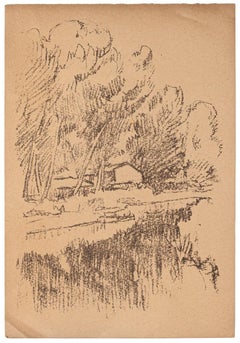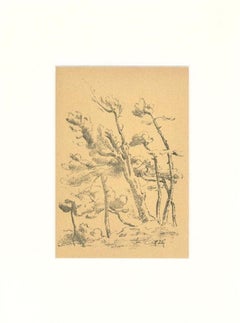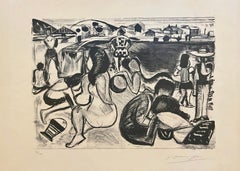Raffaele De Grada Prints and Multiples
Italian, 1885-1957
Initially trained by his father, a decorator, in Argentina and then from 1899 in Zurich, De Grada attended the academies of Dresden and Karlsruhe during the period 1902–05. Influenced by the Swiss secession movement, he enjoyed success as a landscape painter from 1913.
He moved to San Gimignano after World War I, then to Florence, where he lived until 1929. He joined the Novecento Italiano movement and participated in their two exhibitions in Milan (1926 and 1929) as well as their exhibitions collective in other Italian and European cities. His participation in the Venice Biennale began by invitation with the 13th Venice International Art Exhibition in 1922.
After moving to Milan in 1930, he obtained a professorship at the Monza School of Art in 1931. Particularly known for his beautiful views of the Tuscan countryside, De Grada welcomed different generations of artists into his home, including members of the Corrente movement, with whom he also exhibited works in the collective exhibition of the Society of Fine Arts and the Permanent Exhibition in 1939. He participated in numerous exhibitions after the Second World War.
Died in 1957.to
1
2
Overall Width
to
Overall Height
to
6
1,185
940
886
817
2
1
1
2
1
1
1
1
2
Artist: Raffaele De Grada
Landscape - Lithograph by Raffaele De Grada - 1946
By Raffaele De Grada
Located in Roma, IT
Landscape is an original lithograph realized in the 1946 by Raffaele De Grada.
The State of preservation is very good with very small folding along the margi...
Category
1940s Raffaele De Grada Prints and Multiples
Materials
Lithograph
$207 Sale Price
30% Off
Landscape - Woodcut by Raffaele De Grada - 1970s
By Raffaele De Grada
Located in Roma, IT
Landscape is an original woodcut realized in the 1970s by Raffaele De Grada
Signed on the lower right.
The State of preservation is very good.
Passepartout...
Category
1970s Raffaele De Grada Prints and Multiples
Materials
Woodcut
Related Items
Clemente Untitled B: surreal mythical landscape, voyage with ocean, Venus, snake
By Francesco Clemente
Located in New York, NY
A black and white, large-scale surreal mythical landscape of an ocean voyage, with a snake wrapped around a clock, a ship, Venus sculpture, greek urns, and snakes, printed in black o...
Category
1980s Contemporary Raffaele De Grada Prints and Multiples
Materials
Lithograph
$2,975
H 26.75 in W 119.25 in
Untitled abstract seaside, original lithograph
By François Desnoyer
Located in Belgrade, MT
Pencil signed black and white lithograph original limited edition pencil signed , Guilde De La Gravure. Mid 20th Century, part of my private collection. Very Good condition.
Category
Mid-20th Century Cubist Raffaele De Grada Prints and Multiples
Materials
Lithograph
$636 Sale Price
33% Off
H 13 in W 15 in
Prodigal Son
By Thomas Hart Benton
Located in London, GB
A man raises his hand to his chin, his neck tilted and face turned to look at a dilapidated farmhouse, barely held together by planks of wood and exposed to the elements. Behind him ...
Category
1930s American Modern Raffaele De Grada Prints and Multiples
Materials
Lithograph
“Thebes, Great Hall at Karnak”
By David Roberts
Located in San Francisco, CA
This lithograph titled "Thebes, Great Hall at Karnak" is a notable work by the Scottish painter David Roberts (1796-1864). This particular scene is part of Roberts' most famous colle...
Category
1840s English School Raffaele De Grada Prints and Multiples
Materials
Paper, Lithograph
All The Things - Surfing Art - Figurative - Woodcut Print By Marc Zimmerman
By Marc Zimmerman
Located in Carmel, CA
All The Things - Surfing Art - Figurative - Woodcut Print By Marc Zimmerman
Limited Edition 01/04
This masterwork is exhibited in the Zimmerman Gallery, Carmel CA.
Immerse yoursel...
Category
2010s Contemporary Raffaele De Grada Prints and Multiples
Materials
Woodcut
Down the River
By Thomas Hart Benton
Located in London, GB
In this sentimental work from 1939, Benton expresses his admiration for the rural lifestyle of the Midwest. He highlights the connection between man and the land by depicting two fig...
Category
1930s American Modern Raffaele De Grada Prints and Multiples
Materials
Lithograph
Surf Elements - Surfing Art - Figurative - Woodcut Print By Marc Zimmerman
By Marc Zimmerman
Located in Carmel, CA
Surf Elements - Surfing Art - Figurative - Woodcut Print By Marc Zimmerman
Limited Edition 01/04
This masterwork is exhibited in the Zimmerman Gallery, Carmel CA.
Immerse yourself...
Category
2010s Contemporary Raffaele De Grada Prints and Multiples
Materials
Woodcut
“Winter” from the “Four Seasons Suite” Series
By Alvar Sunol Munoz-Ramos
Located in San Francisco, CA
This embossed, numbered and signed lithograph, part of the “Four Seasons Suite,” is by Alvar Suñol Muñoz-Ramos (b. 1935), a renowned Spanish ar...
Category
1970s Modern Raffaele De Grada Prints and Multiples
Materials
Paper, Lithograph
$1,350
H 37.25 in W 30.5 in D 2 in
Vintage David Hockney Poster Miami New World Festival of Arts 1982 palm trees
By David Hockney
Located in New York, NY
This vintage David Hockney poster features whimsical imagery and rich, bright color. Palm trees, boats in the ocean, a cafe, and a bodega with an elaborate iron-wrought balcony sit a...
Category
1980s Realist Raffaele De Grada Prints and Multiples
Materials
Lithograph
"Gothic Gables" New York Graphic Society 1966, Printed in Switzerland
By Lyonel Feininger
Located in Chesterfield, MI
"Gothic Gables" Poster/Print by LYONEL FEININGER (American-German, 1871-1956). The print measures approximately 20 x 27 inches and is unframed. Published by New York Graphic Society 1966. Printed in Switzerland...
Category
1960s Raffaele De Grada Prints and Multiples
Materials
Lithograph
$160 Sale Price
20% Off
H 20 in W 27 in
Three Turns - Surfing Art By Marc Zimmerman
By Marc Zimmerman
Located in Carmel, CA
Three Turns - Surfing Art - Figurative - Woodcut Print By Marc Zimmerman
Limited Edition 01/04
This masterwork is exhibited in the Zimmerman Gallery, Carmel CA.
Immerse yourself i...
Category
2010s Contemporary Raffaele De Grada Prints and Multiples
Materials
Woodcut
Tight Tuck - Surfing Art - Figurative - Woodcut Print By Marc Zimmerman
By Marc Zimmerman
Located in Carmel, CA
Tight Tuck - Surfing Art - Figurative - Woodcut Print By Marc Zimmerman
Limited Edition 01/04
This masterwork is exhibited in the Zimmerman Gallery, Carmel CA.
Immerse yourself in...
Category
2010s Contemporary Raffaele De Grada Prints and Multiples
Materials
Woodcut
Raffaele De Grada prints and multiples for sale on 1stDibs.
Find a wide variety of authentic Raffaele De Grada prints and multiples available for sale on 1stDibs. You can also browse by medium to find art by Raffaele De Grada in lithograph, woodcut print and more. Not every interior allows for large Raffaele De Grada prints and multiples, so small editions measuring 7 inches across are available. Raffaele De Grada prints and multiples prices can differ depending upon medium, time period and other attributes. On 1stDibs, the price for these items starts at $223 and tops out at $223, while the average work can sell for $223.



